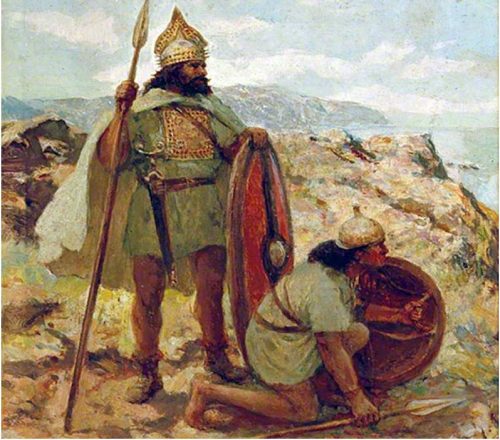This is an interesting map on the Growth of the Swedish empire in 1560-1660. Acquisitions are noted in accordance with the reigns of the respective Swedish kings. Note that in 1560 the Kingdom of Sweden had already
More
The Growth of the Swedish empire
08/07/2019
Uncategorized Denmark, Europe, European Union, Finland, Military, Military history, Military topics, Norway, Poland, Scandinavia, Sweden, Swedish Leave a comment
15th April 2019: Day of grief for France, the EU, Christianity and World Heritage. 20 April: Day of hope and remedy
20/04/2019
Uncategorized Europe, European, European Union, Europeans, France, French, French Architecture, French engineering, Parthenon Leave a comment
Photo credit: Sky News (News.sky.com)
.
I waited for a few days for this tribute post on the destruction of a part of Notre Dame (the building’s spire and most of its roof had collapsed, and its upper walls had been severely damaged; extensive damage to the interior was prevented by its stone vaulted ceiling, which largely contained the burning roof as it collapsed). As a European I grieve for this misfortune but I’m also so optimistic about its instauration: Tomorrow, I am sure that the Day of Resurrection of our Lord Jesus Christ (according to the Catholic calendar – I happen to be an Orthodox) will also mark the start of the resurrection and total remedy of Notre Dame.
Taking into account the aspect of engineering, the damages are definitely repairable and that is the fortunate element in this misfortune for France and the EU.
P. Mitochondrial Genomes Suggest a Single Major Dispersal of Non-Africans and a Late Glacial Population Turnover in Europe
19/10/2017
Uncategorized Anthropology, Biology, Europe, European Union, Europeans, Genetics Leave a comment
Republished from Cell.com
Late Pleistocene and Early Holocene Archeological Sites and Hunter-Gatherer mtDNA Haplogroups
(A) Pre-LGM dispersal of non-African populations, carrying both M and N lineages (hgs R, U, U5, and U2′3′4′7′8′9 belong to the N clade, distinct from the M clade).
(B) Post-LGM re-expansion in Europe while ice sheets retracted.
(C) Late Glacial shift in mtDNA hg frequency.
(D) Holocene hunter-gatherer mtDNA, mainly belonging to hg U5.
.
How modern humans dispersed into Eurasia and Australasia, including the number of separate expansions and their timings, is highly debated [1, 2]. Two categories of models are proposed for the dispersal of non-Africans: (1) single dispersal, i.e., a single major diffusion of modern humans across Eurasia and Australasia [3, 4, 5]; and (2) multiple dispersal, i.e., additional earlier population expansions that may have contributed to the genetic diversity of some present-day humans outside of Africa [6, 7, 8, 9]. Many variants of these models focus largely on Asia and Australasia, neglecting human dispersal into Europe, thus explaining only a subset of the entire colonization process outside of Africa [3, 4, 5, 8, 9].
Most European men descend from a handful of Bronze Age ancestors
04/04/2016
Uncategorized Anthropology, Bronze Age, Europe, European, European Union, Europeans, Genetics, Indo-European 3 Comments
Republication from the University of Leicester
.
- Researchers determined DNA sequences from the Y chromosomes of 334 men belonging to 17 populations from Europe and the Middle East
- Study shows that almost two out of three (64%) modern European men belong to just three young paternal lineage
- Male-specific population expansion was widespread, and surprisingly recent, focusing interest on the Bronze Age
Geneticists from the University of Leicester have discovered that most European men descend from just a handful of Bronze Age forefathers, due to a ‘population explosion’ several thousand years ago.
SOME SCENARIOS ON THE OUTCOME OF THE UKRAINIAN CRISIS
29/06/2014
Uncategorized China, Crimea, European Union, Kiev, Orthodox, Russia, Russian, Sevastopol, Ukraine, Ukraine unrest, Ukrainian divide, Uniate, USA Leave a comment
By Periklis Deligiannis

Russian-speaking combatants gather ammunition from the place of crash of a Ukrainian fighter aircraft.
–
Many of us remember the classic book “Clash of Civilizations” (1996) of Samuel Huntington, the main successor to the geopolitical school of the British historian Arnold Toynbee, and his remarks on the bipartition of the cultural identity of Ukraine and Turkey, which is dramatically verified for both of them in the last twelve months. Yet Turkey, despite the dramatic events taking place in the country during the last year, does not wobble as much as Ukraine.
Let’s see how things have developed for the Ukrainian crisis and then some scenarios on its solution. The terms of the recent agreement were not really implemented and the Ukraine is possibly moving towards a more violent confrontation. The “big players” (Russia, U.S., E.U. and China) are rather cautious preferring keep waiting, except the rapid Russian annexation of Crimea.
The Western media have probably overstated the financial dependence of Russia from the Western economies, although the American financial reprisals on her have already been felt in the country. Neither Russia can seriously threaten the U.S. in retaliation, but can push to a certain extent the European Union using energy reprisals. Of course the latter did not have any serious problems of energy supply before the energy agreements with Russia, but it now appears to depend a lot on the inexhaustible Russian gas resources, especially Germany, France and the other Northern European nations.
The Ukrainian crisis is the outcome of the constant attempts of the U.S. and the E.U. to penetrate a geopolitical region which Russia considers exclusively her own since at least 1793. However it seems that they have not anticipated the extent of the internal struggle in Ukraine.
What are the reasons of the current embarrassment of the “major geopolitical players”?










